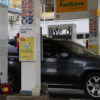
Obama, Xi and Abe, who helm the world’s three biggest economies, were among the leaders at the Asia-Pacific Economic Cooperation (APEC) forum/AFP
US President Barack Obama, Chinese President Xi Jinping and Japanese Prime Minister Shinzo Abe, who helm the world’s three biggest economies, were among the leaders at the Asia-Pacific Economic Cooperation (APEC) forum.
But the parade of initial handshakes at a lakeside conference centre north of the Chinese capital revealed the diplomatic differences between the participants.
Putin and Xi, who praised their mutual friendship at the weekend, nodded and smiled together, while Obama, fresh from announcing a reciprocal deal between Beijing and Washington to extend visa validities, went so far as to tap the Chinese leader on the shoulder, grinning broadly.
Tony Abbott of Australia – a significant source of raw materials for the Chinese economy – was treated to an extended grip.
But China is embroiled in territorial and historic disputes with Japan, and the neighbours held their first top-level formal talks in nearly three years at the weekend.
Shinzo Abe was accorded only a perfunctory handshake by an unsmiling Xi, provoking laughter in the summit media centre.
China wants the 21-member APEC meeting to endorse a stronger commitment to the Free Trade Area of the Asia-Pacific (FTAAP) idea, a longer-term concept for the entire region that would build on other free-trade initiatives including the US-backed Trans-Pacific Partnership (TPP).
“APEC should play a leading and coordinating role and break various fetters to usher in a new round of opening at a broader, higher and more profound level,” Xi told the summit’s opening session, in a colonnaded room.
“We should break open the closed doors within the Asia Pacific. We should… push vigorously for the progress of the FTAAP, setting out clearly its targets, direction and roadmap and turn the desire into reality at an early date.”
But the US has long pushed TPP, which aims for a loosening of trade restrictions, and embracing 11 other Pacific Rim countries including Japan, Canada, Australia and Mexico, while excluding China.
Some Chinese analysts and state media have framed the TPP as an attempt to check Beijing’s growing economic clout, allegations Washington dismisses.
The 10-member Association of Southeast Asian Nations, meanwhile, champions the Regional Comprehensive Economic Partnership, which would bring together ASEAN and six countries with which it has FTAs, including China, Japan and India.
– Pomp and colour –
APEC accounts for more than 50 percent of global gross domestic product, nearly half of world trade and 40 percent of the Earth’s population.
Set up 25 years ago, it has long pushed free trade among its members, who have separately pursued bilateral and multilateral deals with other economies both inside and outside the organisation.
APEC summits, which are consensus-based and have sometimes been criticised as talking shops, combine group meetings with a chance for leaders to meet on the sidelines in one-to-one bilateral sessions to discuss issues that affect their direct relations.
Xi and Abe on Monday held the first summit between Chinese and Japanese leaders since December 2011 as they seek to repair relations soured by disputes over territory and World War II history.
The gatherings also combine serious policy discussions with pomp and colour.
At Monday’s formal dinner that kicked off the summit, the hosts rolled out a gleaming red carpet for the leaders who arrived decked out in sleek, high-collared tunics, with hundreds of wildly cheering dancers dressed in the costumes of China’s dozens of ethnic minorities outside the venue.
Xi offered the world a vision of a Chinese-driven “Asia-Pacific dream” on Sunday in a speech to APEC business leaders, while Obama, speaking to the same audience on Monday, stressed US global leadership, calling his country a “thoroughly Pacific nation”.

































